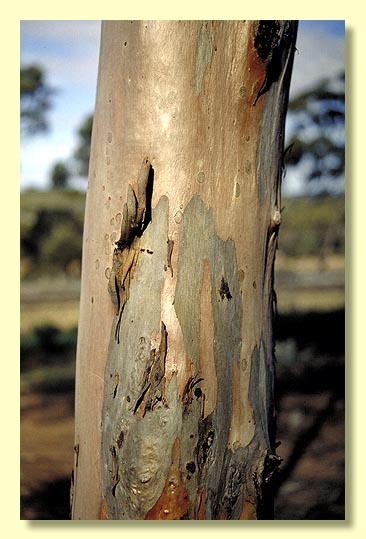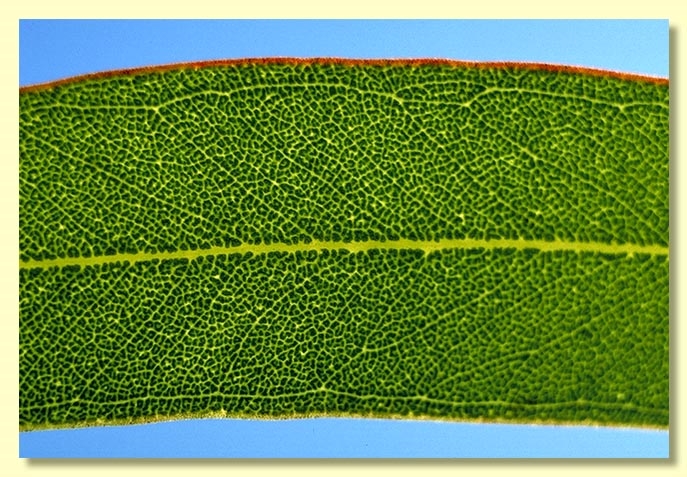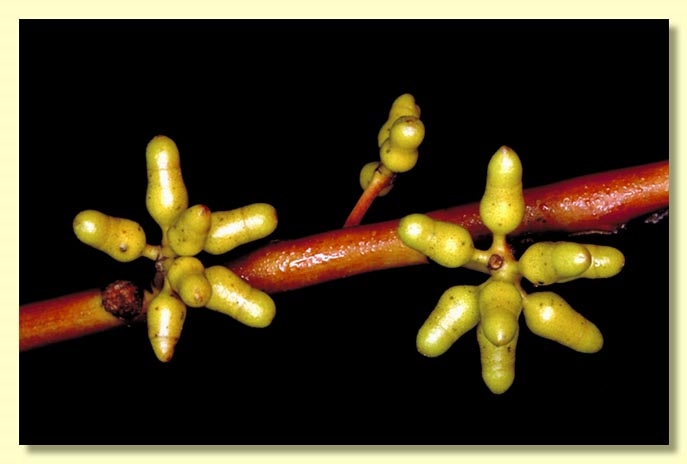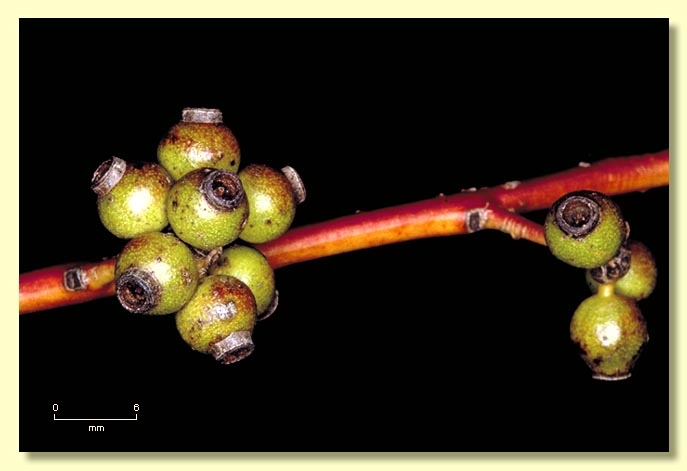Euclid - Online edition
Eucalyptus brockwayi
Eucalyptus | Symphyomyrtus | Bisectae | Destitutae | Brockwayanae
Bark smooth throughout, shiny, mottled light grey, salmon pink and creamy white.
Branchlets lacking oil glands in the pith.
Juvenile growth (coppice or field seedlings to 50 cm): stems rounded in cross-section, or obscurely polygonal; juvenile leaves sessile, spirally arranged, elliptical, 2–7 cm long, 0.5–2.7 cm wide, dull, green.
Adult leaves alternate, petiole 1.2–2 cm long; blade linear to narrowly lanceolate, 7–15 cm long, 0.8–1.8 cm wide, base tapering to petiole, margin entire, apex finely acuminate, green, very glossy, side-veins at an acute or wider angle to midrib, reticulation dense, intramarginal vein close to margin, oil glands obscure or absent.
Inflorescence axillary unbranched, peduncles slightly flattened, 0.5–1.3 cm long, buds 11 to 15 per umbel, pedicellate (pedicels 0.1–0.2 cm long). Mature buds cylindrical to elongated ovoid (0.6–0.8 cm long, 0.3–0.4 cm wide), dilated basally, scar present, operculum bluntly conical to rounded, stamens inflexed, anthers more or less spherical, versatile, sub-basifixed, dehiscing by longitudinal slits, style short and straight, stigma blunt to rounded, locules 3(4), the placentae each with 4 vertical rows of ovules. Flowers white.
Fruit pedicellate to sessile (pedicels 0–0.2 cm long), globular but with conspicuous narrow neck (globular-urceolate), 0.4–0.6 cm long, 0.4–0.7 cm wide, disc descending vertically, valves 3(4) enclosed.
Seeds grey-brown, 1–2 mm long, flattened-ovoid, dorsal surface smooth, hilum ventral.
Cultivated seedlings (measured at ca node 10): cotyledons Y-shaped (bisected); stems round to many-sided, softly hairy with branched hairs; leaves sessile, crowded, spirally arranged from ca node 2 for at least 30 leaves, linear, short, 1–2.7 cm long, 0.1–0.5 cm wide, dull, green, softly hairy.
Flowering has been recorded in March, April and June.
A small tree endemic to Western Australia, found only in the southern goldfields around Norseman on gravelly to sandy loam. The bark is smooth and the adult leaves glossy green with very dense reticulation and apparently without oil glands. Eucalyptus brockwayi is easy to recognise within its natural range because of its basally dilated buds, small globular-urceolate fruit and distinctive, densly reticulate, glandless adult leaves.
Eucalyptus brockwayi belongs in Eucalyptus subgenus Symphyomyrtus section Bisectae subsection Destitutae because the buds have two opercula, cotyledons are Y-shaped and the branchlets have no oil glands in the pith. Within this subsection E. brockwayii has no closely related species and forms the monotypic series Brockwayanae.
The most remarkable feature of this species is the seedlings, which are like no other eucalypt, having linear leaves that are softly pubescent and crowded irregularly on the stem (not opposite, nor alternate nor clearly spirally arranged)













